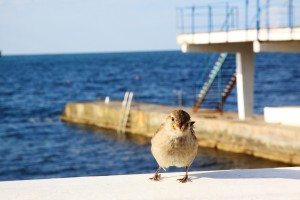 The Cape Sable seaside sparrow is an endangered species in the Everglades. In order for this bird to survive in the Everglades, an ideal water level for this bird must be maintained, and that is no easy task.
The Cape Sable seaside sparrow is an endangered species in the Everglades. In order for this bird to survive in the Everglades, an ideal water level for this bird must be maintained, and that is no easy task.
Between April and July, the sparrow builds its nests a mere six inches off the ground, so it needs a water level high enough to keep it away from predators and low enough, so the nest doesn’t wash away. This bird is nicknamed the “Goldilocks bird” because its habitat conditions have to be “just right” for it to survive. In 1981, there were an estimated 6,656 Cape Sable seaside sparrows in the Everglades, but by 2002 there were only around 2,624 of the birds around.
The sparrow lives in six different locations of the Everglades, usually rocky grass prairies with muhly grass; the Everglades is the only ecosystem the bird exists in. In these short-hyrdoperiod prairies, there is somewhat dense, clumped grasses with open space for the sparrows to move around. The sparrows’ nests are cup-shaped, and the bird itself is only 5 inches long. The sparrow is a dark olive gray in color with a brown back and light gray with dark olive color lines on the sides; there are small patches of yellow feathers around the eyes and the bend of the wings. These birds feed on grasshoppers, caterpillars, beetles, spiders, and seeds from the grass. They are known to have short-range movements and do travel far away from their nesting areas outside of the breeding season. A sparrow usually only lives to the age of four.
According to the U.S. Army Corp of Engineers, the condition of the sparrow is so dire and they’re trying to do anything they can to save them, even if this means giving one pair of sparrows the opportunity to breed. They believe this year will be the worst breed year they’ve seen for the sparrow in decades.
Spot the Sparrow
The Capble Sable seaside sparrow is disappearing. A change in a mere couple of centimeters of water in the sparrow’s habitat can determine whether or not the birds can or will breed. Scientists and officials are continuing to work on restorations plans that will protect the bird and its environment without causing too many problems elsewhere. Getting the Everglades back to its original state, will help this bird and many other species. The restored water flows which will help keep the rise of sea level at bay.
If you’d like an opportunity to see a sparrow fly by, an airboat tour may be your chance. Airboats can bring you all around the Everglades to places you cannot get to by foot. To explore the Everglades, contact Captain Mitch’s Airboat Tours.
Captain Mitch’s Everglades Private Airboat Tours is open 7 days a week from 8:30 a.m. to 4:30 p.m. If paying by cash, adults cost $40 (plus tax) and children 12 and under cost $20 (plus tax. If paying by credit card, adults cost $45 (plus tax) and children cost $25 (plus tax).
To book an airboat trip in the Everglades, call Captain Mitch’s Airboat Tours at 239-695-3377 or click Everglades airboat tour page.






